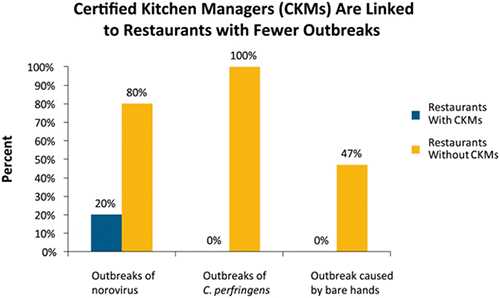Food Safety Differences Between Restaurants Linked and Not Linked to Outbreaks
This page shows the study purpose, method, results, conclusions, and recommendations in plain language for the EHS-Net project titled Evaluation of Outbreak and Nonoutbreak Restaurants.
The findings and recommendations from this project are also in fact sheet format [PDF - 312 KB].
Citations for more EHS-Net publications are available by Study Topic or by Citation.

Study Problem
Each year, roughly 1 in 6 people in the United States gets sick from eating contaminated food. We need to know the causes of foodborne illness outbreaks so we can prevent future outbreaks. This study focused on restaurants because they are the most common place for outbreaks to occur.
Study Purpose
This study described how restaurant traits (for example, number of meals served), policies, and practices were linked to foodborne illness outbreaks and to infected food workers as the cause of outbreaks.
Study Findings in Brief
EHS-Net found that restaurants with kitchen managers certified in food safety were less likely to have foodborne illness outbreaks.
Study Method
Participants
We collected data in restaurants located in the EHS-Net sites. In each restaurant, we interviewed a manager or worker about restaurant traits (e.g., restaurant type, policies, etc).
We collected data from two groups of restaurants:
- Outbreak restaurants. These were restaurants that had a foodborne illness outbreak during our study. Outbreaks were defined as foodborne illnesses where two or more people ate a common meal in a restaurant and there were no other likely common exposures.
- Nonoutbreak restaurants. These were restaurants with no history of outbreaks in the previous 3 years and no complaints of food-related illness in the previous year.
Data Collection
State or local environmental health specialists evaluated 22 outbreak restaurants and 347 nonoutbreak restaurants. We collected data on restaurant traits such as training and certification, and policies and practices. In outbreak restaurants we also collected data on causes of outbreaks.
Top of PageStudy Results
Description of Outbreaks
- Outbreaks of norovirus were the most common (45%).
- The most common causes of outbreaks were infected food workers (65%) and workers touching food with their bare hands (35%).
Restaurant Traits Linked to Outbreaks
Outbreak and nonoutbreak restaurants were similar on these traits:
- Ownership (chain vs. independent).
- Number of meals served.
- Food-safety training.
- Language barriers.
- Sick leave pay.
- Policies to keep sick workers from working.
Outbreak restaurants were less likely to have
- A certified kitchen manager (CKM) on staff.
- Food-safety certification training provided by a state or local agency.
- Food-safety certification training provided by a restaurant corporation.
Outbreak restaurants were more likely to be
- Sit-down restaurants.
- Classified as ethnic restaurants.
Outbreak restaurants with CKMs were less likely than outbreak restaurants without CKMs to have had outbreaks
- Of norovirus and Clostridium perfringens.
- Caused by workers touching food with their bare hands.
Within outbreak restaurants, CKMs were more likely than other managers to be familiar with the Hazard Analysis Critical Control Point (HACCP) system. All CKMs were familiar with the HACCP food-safety system recommended by the U.S. Food and Drug Administration. Twenty percent of other managers were familiar with HACCP.
Restaurant Traits Linked to Infected Food Handlers
Kitchen manager certification, sick leave pay, and policies to keep sick workers from working did not lower rates of infected food handlers as a cause of outbreaks.
Study Conclusions
Restaurants with CKMs had a lower risk for outbreaks.
Kitchen manager certification and policies to keep sick workers from working were not linked with a lower likelihood of an outbreak being caused by an infected food handler.
Outbreak restaurants with CKMs were less likely than those without CKMs to have outbreaks of norovirus and C. perfringens. Outbreaks were also less likely to have been caused by worker touching food with bare hands.
Awareness of HACCP by CKMs may have led to better control of bare-hand contact with food (a cause of norovirus) and of food temperatures during cooling and reheating (a cause of C. perfringens).
Sit-down and ethnic restaurants were more likely to have outbreaks. But they are also more likely to have complex food preparation, which is also a factor in outbreaks. So these traits may be a proxy for complex food preparation. More work is needed to find the link between these traits and outbreaks.
Nonoutbreak restaurants were more likely to have had CKM training from a public agency or restaurant corporation. This suggests that training quality may be linked to whether an outbreak occurs.

Norovirus: 20% of outbreaks occurred in restaurants with a CKM; 80% occurred in restaurants without a CKM. C. perfringens: No outbreaks occurred in restaurants with a CKM; 100% occurred in restaurants without a CKM. Bare-hand contact with food was not a contributing factor in any outbreaks in restaurants with a CKM. It was a contributing factor in 47% of outbreaks in restaurants without a CKM.
EHS-Net Recommends
Restaurants should consider requiring kitchen manager food-safety certification from a high-quality training program.
More research is needed to find out how to reduce outbreaks caused by infected food handlers. In the meantime, restaurants should stress the importance of managing illness of food workers.
Key Terms
- Certified kitchen manager: manager who passed a test to show knowledge of food safety.
- HACCP: a seven-step approach to identify and manage food-safety hazards.
- Page last reviewed: April 9, 2012
- Page last updated: August 16, 2016
- Content source:


 ShareCompartir
ShareCompartir